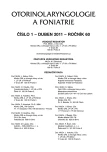Schalek P.: Endonasal Endoscopic Coagulation of a. sphenopalatina in the Therapy of Severe Epistaxis from Posteriori Part of Nasal Cavity
Authors:
P. Schalek
Authors‘ workplace:
ORL klinika 3. LF UK a FNKV, Praha, přednosta doc. MUDr. A. Hahn, CSc.
Published in:
Otorinolaryngol Foniatr, 60, 2011, No. 1, pp. 43-45.
Category:
Original Article
Overview
Epistaxis represents a common and in most cases a trivial health problem which meets most of the population. Only 10 % of patients are forced to seek medical help. One tenth of people visiting the physician present more severe bleeding from posterior and cranial parts of the nasal cavity. In these cases of life-threatening epistaxis, when the bleeding is not controlled by packing, a surgical intervention is necessary. The presented paper describes the surgical procedure of endonasal endoscopic coagulation of sphenopalatine artery and its results in patients who have been operated on ENT clinic of 3rd Medical Faculty of Charles University. Between years 2004-2009 this procedure was performed seven times with efficacy 86 %. Endonasal endoscopic coagulation of a. sphenopalatina represents, at certain level of surgical skills and adequate technical equipment, effective and safe surgical treatment of posterior epistaxis.
Key words:
epistaxis, sphenopalatine artery, surgery.
Sources
1. ElGuindy, A.: Endoscopic transseptal sphenopalatine artery for intractable posterior epistaxis. Ann. Otol Rhinol Laryngol., 107, 1998, s. 1033-1037.
2. Elwany, S., Al-Medany, M. A., Khalifa, H. M., Abdel Salam, S., Soliman, A., Abu El-Kheir, O.: The nasal seromucinous glands after endoscopic sphenopalatine coagulation. Eur Arch. Otorhinolaryngol, 266, 2009, s. 1417-1422.
3. Feusi, B., Holzmann, D. Steurer, J.: Posterior epistaxis: systematic review on the effectiveness of surgical therapies. Rhinology, 44, 2005, s. 300-304.
4. Holzmann, D., Kaufmann, T., Pedrini, P., Valvanis, A.: Posterior epistaxis: endonasal exposure and occlusion of the branches of the sphenopalatine artery. Eur Arch. Otorhinolaryngol, 260, 2003, s. 425-428.
5. Chandler, J. R., Serrins, A. J.: Transantral ligation of the internal maxillary artery of epistaxis. Laryngoscope, 75, 1965, s. 1151-1159.
6. Mahmood, S., Lowe, T.: Management of epistaxis in the orla and maxillofacial surgery setting: An update on currenr practice. Oral Surg. Oral Med. Oral Patol. Oral Radiol. Endod., 95, 2003, s. 23-29.
7. Montgomery, W. W., Reardon, E. J.: Early vessel ligation for control of severe epistaxis. In: Snow, J. B.: Controversies in otolaryngology. Philadelphia,WB Saunders, 1980, s. 315-319.
8. Petruson, B., Rudin, R.: The frequency of epistaxis in a male population sample. Rhinology, 13, 1975, s. 129-133.
9. Prades, J.: Abord endonasal de la fosse pterygo-maxillaire. LXXIII Cong. Franc Compt. Rendus des Seance, 1976, s. 290-296.
10. Sharp, H. R., Rowe-Johns, J. M., Biring, G.S., Mackay, I. S.: Endoscopic ligation or diathermy of the sphenopalatine artery in persistent epistaxis. J. Laryngol Otol., 111, 1997, s. 1047-1050.
11. Tsai, H. M., Shu, C. H.: Transnasal sphenopalatine artery electrocautery for posterior epistaxis. Chung Hua i Hsueh Tsa Chih – Chin. Med. J., 65, 2002, s. 529-533.
Labels
Audiology Paediatric ENT ENT (Otorhinolaryngology)Article was published in
Otorhinolaryngology and Phoniatrics

2011 Issue 1
Most read in this issue
- Lipový B., Řihová H., Kaloudová Y., Jonášek M., Suchánek I., Gregorová N., Brychta P.: Inhalation Trauma – History, Present and Future
- Krempaská S., Kovaľ J. : Complications after Eardrum Membrane Reconstruction
- Dytrych P., Katra R., Jurovčík M., Karmanová D., Šnajdauf J., Kabelka Z.: Laryngotracheoesophageal Cleft
- Hajtmanová E., Hajtman A., Kinclová I., Muríň P., Lietava P., Hajtman A., Péč M.: Percutaneous Endoscopic Gastrostomy in the Therapy of Patients with Advanced Head and Neck Tumors
